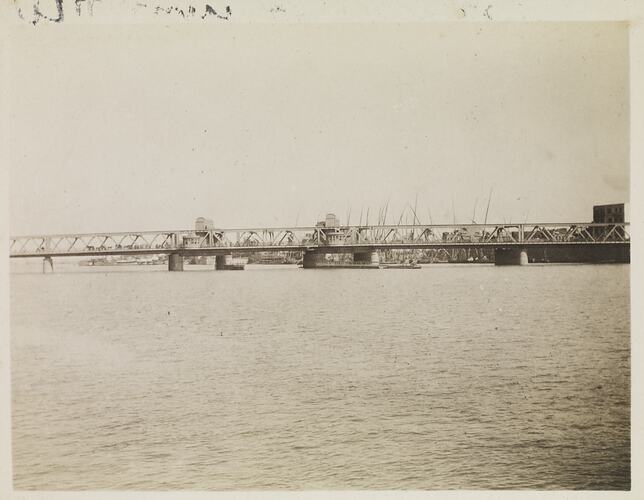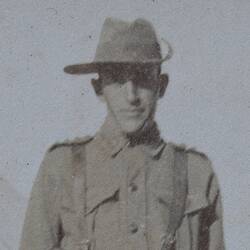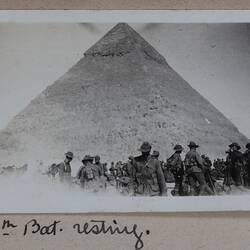Summary
One of 108 images in an album from World War I likely to have been taken by Captain Edward Albert McKenna. The album contains photographs of the 7th Battalion in Egypt.
Image of the Boulac Bridge, Cairo. The Boulac (or Boulak) Bridge was designed by American architect William Donald Scherzer and used a rolling (bascules) and locking mechanism for opening. The bridge took three and a half years to build and was 274.3m long and 20m wide. It opened with little fuss in July 1912 as Boulac Bridge, it was later renamed Fouad Birdge and then Abou al-Ela Bridge. Boulac Bridge was dismantled in 1996 after being deemed insufficient to cope with Cairo's traffic.
The album relates to the service of Captain Edward Albert McKenna. McKenna, born in Castlemaine, Victoria, was a 36-year-old department manager of soft goods when he enlisted on 17 August 1914. He lived at 5 St James Buildings, William Street, Melbourne, and had been married to Elizabeth ('Lillie') Mary McKenna since 1910. He embarked from Melbourne 19 October 1914 on the HMAT Hororata, and served in the 7th Battalion Australian Infantry.
He was killed in action in Gallipoli around 25-30 April 1915, aged 37. His kit bag was unusually full, even containing seven shirts, a pillow, six towels, a travelling rug, gumboots, and pyjamas and slippers. Also amongst his possessions was a camera, although no photographic prints or albums.
He was buried at 7 Lone Pine Cemetery, Gallipoli. His details appear on the honours roll on the web page of the Australian War Memorial.
Description of Content
Photograph of a bridge, possibly the Boulac bridge.
Physical Description
Black and white photographic print on paper with a white border.
More Information
-
Collection Names
Returned and Services League (RSL) Collection, Military Memorabilia Collection
-
Collecting Areas
-
Acquisition Information
Donation from Mr J. Willis, circa 1986
-
Acknowledgement
Mr. J. Willis
-
Place & Date Depicted
-
Photographer
Captain Edward A. McKenna - Australian Imperial Force (AIF), Egypt, 1914-1915
-
Creator
-
Inscriptions
Hand-written in black ink on the support on the left of the image: 'Boulac / Bridge / Cairo' Hand-written in pencil on the back of the photograph: 'Boulac Bridge / Cairo'
-
Classification
-
Category
-
Discipline
-
Type of item
-
Image Dimensions - Photograph
108 mm (Width), 84 mm (Height)
-
Image Dimensions - Photograph album page
174 mm (Width), 141 mm (Height)
-
References
National Archives of Australia: McKenna Edward Albert, barcode 1949283, series B2455/1. Samir Raafat, 'A Bridge Misunderstood: and other Cairo crossings,' Egyptian Mail, Saturday, April 29, 1995, at: [Link 1] accessed: January 9, 2013 'Resurrecting Boulac Bridge,' Cairo Observer, 22 December, 2011, at: [Link 2] accessed: January 9, 2013
-
Keywords
Military History, World War I, 1914-1918, Bridges, Waterways, Rivers


